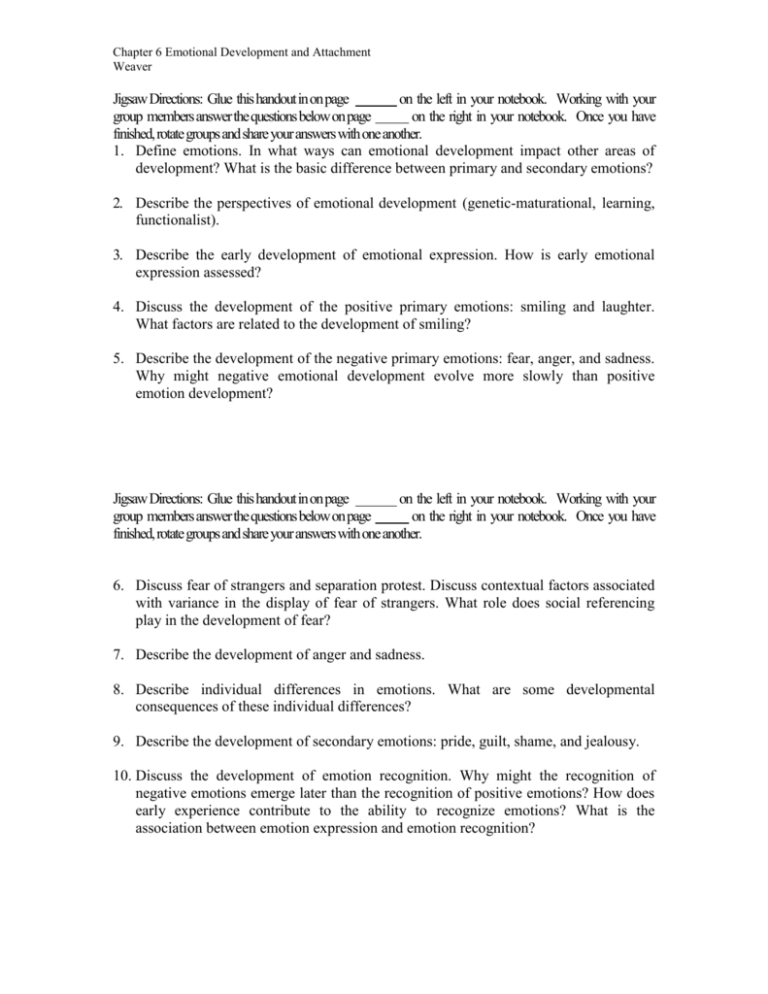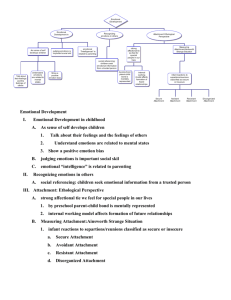Chap. 6-Learning Objectives Q & A
advertisement

Chapter 6 Emotional Development and Attachment Weaver Jigsaw Directions: Glue this handout in on page on the left in your notebook. Working with your group members answer the questions below on page on the right in your notebook. Once you have finished, rotate groups and share your answers with one another. 1. Define emotions. In what ways can emotional development impact other areas of development? What is the basic difference between primary and secondary emotions? 2. Describe the perspectives of emotional development (genetic-maturational, learning, functionalist). 3. Describe the early development of emotional expression. How is early emotional expression assessed? 4. Discuss the development of the positive primary emotions: smiling and laughter. What factors are related to the development of smiling? 5. Describe the development of the negative primary emotions: fear, anger, and sadness. Why might negative emotional development evolve more slowly than positive emotion development? Jigsaw Directions: Glue this handout in on page on the left in your notebook. Working with your group members answer the questions below on page on the right in your notebook. Once you have finished, rotate groups and share your answers with one another. 6. Discuss fear of strangers and separation protest. Discuss contextual factors associated with variance in the display of fear of strangers. What role does social referencing play in the development of fear? 7. Describe the development of anger and sadness. 8. Describe individual differences in emotions. What are some developmental consequences of these individual differences? 9. Describe the development of secondary emotions: pride, guilt, shame, and jealousy. 10. Discuss the development of emotion recognition. Why might the recognition of negative emotions emerge later than the recognition of positive emotions? How does early experience contribute to the ability to recognize emotions? What is the association between emotion expression and emotion recognition? Chapter 6 Emotional Development and Attachment Weaver Jigsaw Directions: Glue this handout in on page on the left in your notebook. Working with your group members answer the questions below on page on the right in your notebook. Once you have finished, rotate groups and share your answers with one another. 11. Discuss early forms of emotion regulation and emotional display rules and the role of the family in contributing to the development of emotion regulation. 12. Explain emotional scripts and children’s awareness of when to express certain emotions. 13. Describe the development of children’s understanding of the meaning of emotions and their ability to differentiate and integrate two or more emotions simultaneously. 14. Describe the ways in which the family plays a role in all aspects of children’s emotional development. 15. Discuss the major theories of attachment (psychoanalytic, learning, cognitive, ethological). Discuss the role of fathers and other attachment figures. Jigsaw Directions: Glue this handout in on page on the left in your notebook. Working with your group members answer the questions below on page on the right in your notebook. Once you have finished, rotate groups and share your answers with one another. 16. Discuss methods of assessing attachment. Identify the main attachment classifications. Describe the parents’ role in the quality of attachment (e.g., styles of caregiving). 17. Discuss how attachment evolves (preattachment, attachment in the making, clear-cut attachment, goal-directed partnership). 18. Discuss how internal working models influence the intergenerational continuity of attachment. 19. What effect does infant temperament have on attachment formation? 20. Discuss the stability of attachment and the consequences of attachment for socioemotional development. 21. Discuss the effects of multiple attachments and multiple caregivers on the quality of attachment, including the data on day care.






